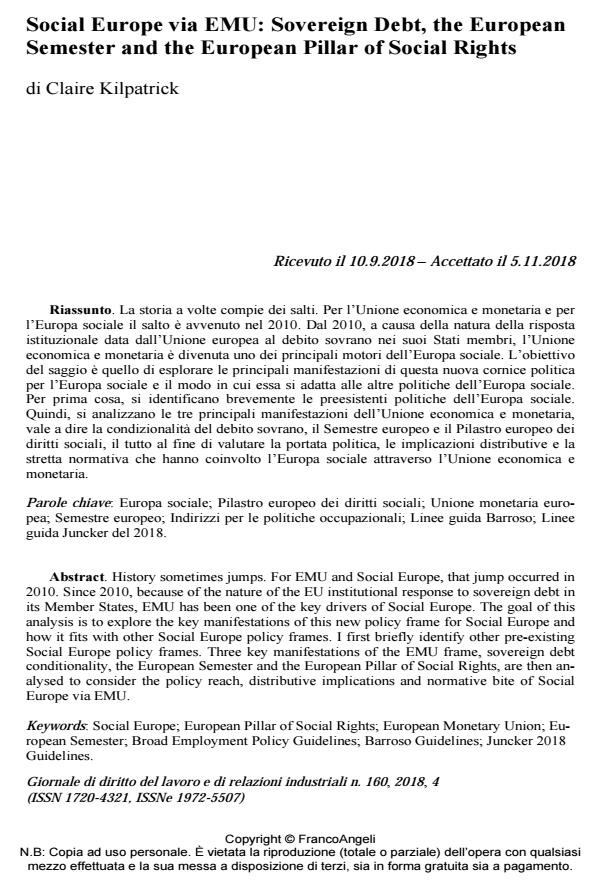Social Europe via EMU: Sovereign Debt, the European Semester and the European Pillar of Social Rights
Titolo Rivista GIORNALE DI DIRITTO DEL LAVORO E DI RELAZIONI INDUSTRIALI
Autori/Curatori Claire Kilpatrick
Anno di pubblicazione 2019 Fascicolo 2018/160
Lingua Inglese Numero pagine 23 P. 737-759 Dimensione file 276 KB
DOI 10.3280/GDL2018-160003
Il DOI è il codice a barre della proprietà intellettuale: per saperne di più
clicca qui
Qui sotto puoi vedere in anteprima la prima pagina di questo articolo.
Se questo articolo ti interessa, lo puoi acquistare (e scaricare in formato pdf) seguendo le facili indicazioni per acquistare il download credit. Acquista Download Credits per scaricare questo Articolo in formato PDF

FrancoAngeli è membro della Publishers International Linking Association, Inc (PILA)associazione indipendente e non profit per facilitare (attraverso i servizi tecnologici implementati da CrossRef.org) l’accesso degli studiosi ai contenuti digitali nelle pubblicazioni professionali e scientifiche
History sometimes jumps. For EMU and Social Europe, that jump occurred in 2010. Since 2010, because of the nature of the EU institutional response to sovereign debt in its Member States, EMU has been one of the key drivers of Social Europe. The goal of this analysis is to explore the key manifestations of this new policy frame for Social Europe and how it fits with other Social Europe policy frames. I first briefly identify other pre-existing Social Europe policy frames. Three key manifestations of the EMU frame, sovereign debt conditionality, the European Semester and the European Pillar of Social Rights, are then analysed to consider the policy reach, distributive implications and normative bite of Social Europe via EMU.
La storia a volte compie dei salti. Per l’Unione economica e monetaria e per l’Europa sociale il salto è avvenuto nel 2010. Dal 2010, a causa della natura della risposta istituzionale data dall’Unione europea al debito sovrano nei suoi Stati membri, l’Unione economica e monetaria è divenuta uno dei principali motori dell’Europa sociale. L’obiettivo del saggio è quello di esplorare le principali manifestazioni di questa nuova cornice politica per l’Europa sociale e il modo in cui essa si adatta alle altre politiche dell’Europa sociale. Per prima cosa, si identificano brevemente le preesistenti politiche dell’Europa sociale. Quindi, si analizzano le tre principali manifestazioni dell’Unione economica e monetaria, vale a dire la condizionalità del debito sovrano, il Semestre europeo e il Pilastro europeo dei diritti sociali, il tutto al fine di valutare la portata politica, le implicazioni distributive e la stretta normativa che hanno coinvolto l’Europa sociale attraverso l’Unione economica e monetaria.
Parole chiave:Europa sociale; Pilastro europeo dei diritti sociali; Unione monetaria europea; Semestre europeo; Indirizzi per le politiche occupazionali; Linee guida Barroso; Linee guida Juncker del 2018.
Claire Kilpatrick, Social Europe via EMU: Sovereign Debt, the European Semester and the European Pillar of Social Rights in "GIORNALE DI DIRITTO DEL LAVORO E DI RELAZIONI INDUSTRIALI " 160/2018, pp 737-759, DOI: 10.3280/GDL2018-160003